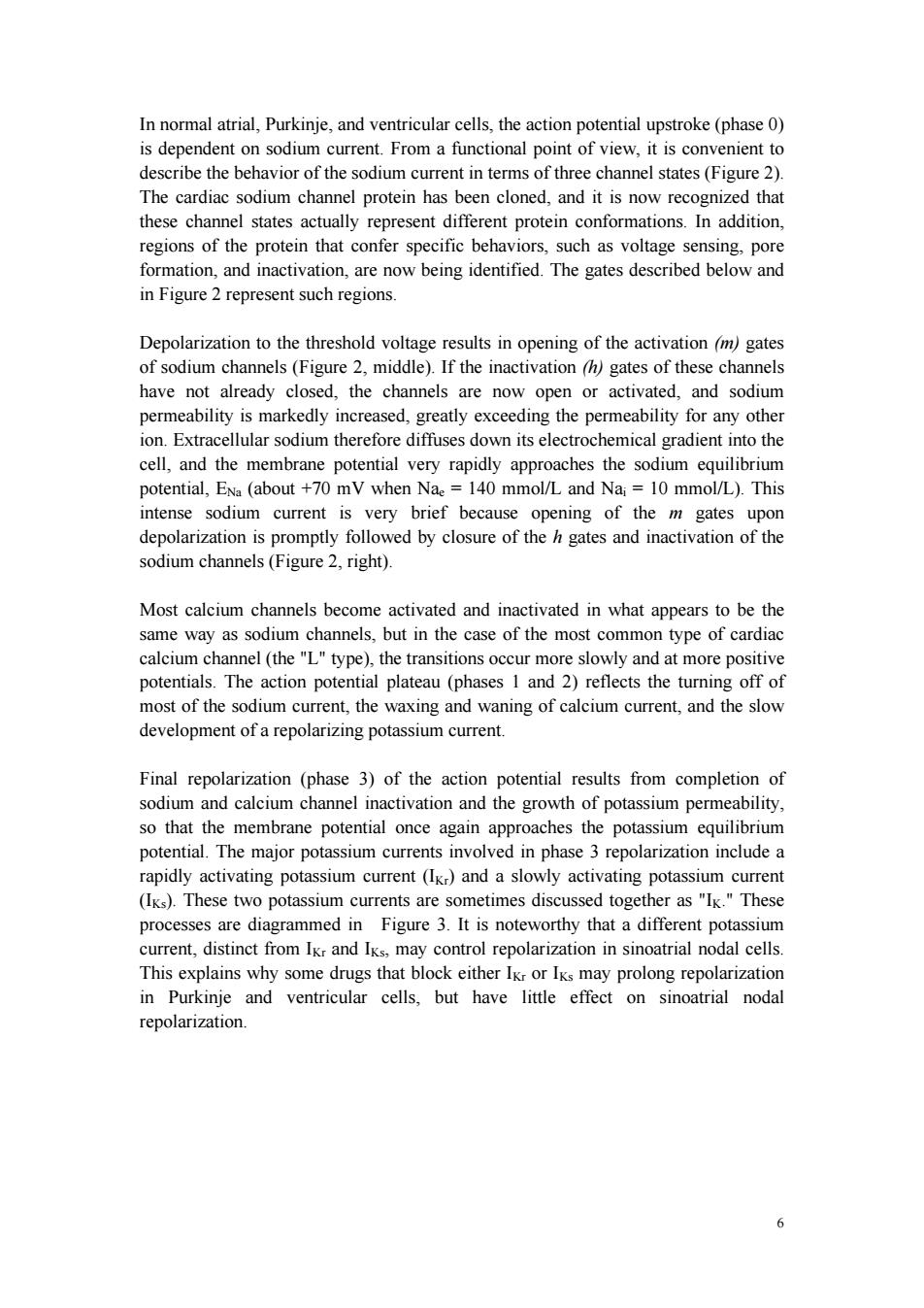正在加载图片...

In normal atrial,Purkinje,and ventricular cells,the action potential upstroke (phase 0) is dependent on sodium current.From a functional point of view,it is convenient to describe the behavior of the sodium current in terms of three channel states(Figure 2). The cardiac sodium channel protein has been cloned,and it is now recognized that these channel states actually represent different protein conformations.In addition, regions of the protein that confer specific behaviors,such as voltage sensing,pore formation,and inactivation,are now being identified.The gates described below and in Figure 2 represent such regions. Depolarization to the threshold voltage results in opening of the activation (m)gates of sodium channels(Figure 2,middle).If the inactivation (h)gates of these channels have not already closed,the channels are now open or activated,and sodium permeability is markedly increased,greatly exceeding the permeability for any other ion.Extracellular sodium therefore diffuses down its electrochemical gradient into the cell,and the membrane potential very rapidly approaches the sodium equilibrium potential,ENa (about +70 mV when Nae 140 mmol/L and Nai 10 mmol/L).This intense sodium current is very brief because opening of the m gates upon depolarization is promptly followed by closure of the h gates and inactivation of the sodium channels(Figure 2,right). Most calcium channels become activated and inactivated in what appears to be the same way as sodium channels,but in the case of the most common type of cardiac calcium channel (the "L"type),the transitions occur more slowly and at more positive potentials.The action potential plateau(phases 1 and 2)reflects the turning off of most of the sodium current,the waxing and waning of calcium current,and the slow development of a repolarizing potassium current. Final repolarization (phase 3)of the action potential results from completion of sodium and calcium channel inactivation and the growth of potassium permeability, so that the membrane potential once again approaches the potassium equilibrium potential.The major potassium currents involved in phase 3 repolarization include a rapidly activating potassium current(Ik)and a slowly activating potassium current (Iks).These two potassium currents are sometimes discussed together as "Ik."These processes are diagrammed in Figure 3.It is noteworthy that a different potassium current,distinct from Ikr and Iks,may control repolarization in sinoatrial nodal cells. This explains why some drugs that block either Ikr or Iks may prolong repolarization in Purkinje and ventricular cells,but have little effect on sinoatrial nodal repolarization. 66 In normal atrial, Purkinje, and ventricular cells, the action potential upstroke (phase 0) is dependent on sodium current. From a functional point of view, it is convenient to describe the behavior of the sodium current in terms of three channel states (Figure 2). The cardiac sodium channel protein has been cloned, and it is now recognized that these channel states actually represent different protein conformations. In addition, regions of the protein that confer specific behaviors, such as voltage sensing, pore formation, and inactivation, are now being identified. The gates described below and in Figure 2 represent such regions. Depolarization to the threshold voltage results in opening of the activation (m) gates of sodium channels (Figure 2, middle). If the inactivation (h) gates of these channels have not already closed, the channels are now open or activated, and sodium permeability is markedly increased, greatly exceeding the permeability for any other ion. Extracellular sodium therefore diffuses down its electrochemical gradient into the cell, and the membrane potential very rapidly approaches the sodium equilibrium potential, ENa (about +70 mV when Nae = 140 mmol/L and Nai = 10 mmol/L). This intense sodium current is very brief because opening of the m gates upon depolarization is promptly followed by closure of the h gates and inactivation of the sodium channels (Figure 2, right). Most calcium channels become activated and inactivated in what appears to be the same way as sodium channels, but in the case of the most common type of cardiac calcium channel (the "L" type), the transitions occur more slowly and at more positive potentials. The action potential plateau (phases 1 and 2) reflects the turning off of most of the sodium current, the waxing and waning of calcium current, and the slow development of a repolarizing potassium current. Final repolarization (phase 3) of the action potential results from completion of sodium and calcium channel inactivation and the growth of potassium permeability, so that the membrane potential once again approaches the potassium equilibrium potential. The major potassium currents involved in phase 3 repolarization include a rapidly activating potassium current (IKr) and a slowly activating potassium current (IKs). These two potassium currents are sometimes discussed together as "IK." These processes are diagrammed in Figure 3. It is noteworthy that a different potassium current, distinct from IKr and IKs, may control repolarization in sinoatrial nodal cells. This explains why some drugs that block either IKr or IKs may prolong repolarization in Purkinje and ventricular cells, but have little effect on sinoatrial nodal repolarization